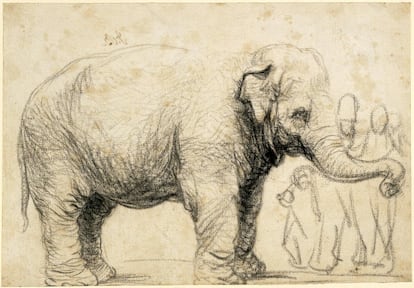Rembrandt: A sketch of Hansken, 1637. Public domain
In 1630, an elephant named
Hansken
was
born in Ceylon, present-day Sri Lanka,
who became famous in Europe.
She was brought to the Netherlands at the age of three for Prince Frederick Henry, the statute - political representative - of the then Republic of the United Provinces, who traded spices in Asia with the East India Company.
Hansken's
Sea
Voyage
It lasted for seven months, and then he not only dazzled audiences with his ability to salute with a hat, raise a sword or carry a flag with his trunk.
It also caught the attention of Rembrandt, the master of the Golden Age, who drew it three times.
The pachyderm now stars in an exhibition at the painter's house museum in Amsterdam, which combines its history as a circus attraction with the artist's passion for capturing his models from nature.
And that also aims to raise awareness about threatened fauna.
More information
Artificial intelligence shows 'The Night Watch' in full for the first time in 300 years
A possible Rembrandt work discovered in a private collection in Rome
The exhibition is titled
Hansken, Rembrandt's Elephant.
Between 1637 and 1641, he drew in detail its wrinkled skin and the movement of its legs and trunk. He was more interested in the animal than in the spectacle it provided, and it did not reflect its abilities but its stamp. The oldest zoo in the world still in operation opened in Vienna in 1752, and the one in Amsterdam dates back to 1838, so that seventeenth-century Europeans were unaware of the diet of elephants and their coexistence in a herd. In the book that accompanies the exhibition, the writer Michiel Roscam Abbing points out that in the 15th century there was a copy on the continent. In the next two centuries they did not exceed two or three, so their power of attraction was evident.
Hansken
it also lay down when asked to do so and caught a bucket of water with its trunk, and onlookers thought that the animal - which ate bread and fruit - had a human brain.
The reality was much more painful. “The journey to Amsterdam was very hard due to the lack of adequate food and water. Also in the hold of the ship were a leopard, a cassowary bird, and a spotted deer. Once in the city, the lack of knowledge led to bringing the four animals together and it was a disaster: the leopard killed the cassowary and
Hansken
sat on top of the deer ”, says, on the phone, Leonore van Sloten, curator of the exhibition. Prince Frederick Henry gave the elephant a gift to his great-nephew, Johan Maurits, who sold it for 8,000 florins. The last owner was Cornelis van Groenevelt, who paid 20,000 florins for it, the price of a good house at the time. “Cornelis knew how to train horses, and saw the commercial possibilities of teaching him tricks -
Hansken
he learned up to 36— and they went on tour in Europe ”, continues the curator. “They were in Germany and France, they crossed the Alps twice and she was carrying the owner and the luggage. They got along well, but it was a life of suffering. "
Rembrandt saw it for the first time in 1637, in a square very close to his house, and he drew it there. A year later, he executed a biblical engraving where the serpent of Paradise is a dragon that tempts Adam and Eve. She added an elephant, supposedly inspired by Hansken, as a symbol of good and chastity, "because it was believed that these animals lacked sexual impulse," adds the expert. In 1641 he caught it again. He had amazed the public, but the itinerant life, poor diet and deprivation of his fellows in a cold climate undermined his health. In October 1655 she arrived in Florence to perform for Cardinal Leopoldo de Medici, and on December 9 she fell dead in the Plaza de la Señora. They thought she may have been poisoned, but later it was found that she had infected leg ulcers. I was 25 years old,when Asian specimens of its kind can live to at least 60, and its ending was captured by Italian artist Stefano della Bella. His drawings and those of Rembrandt are part of the exhibition, as is the skull of
Hansken, on
loan from the Natural History Museum of the Italian city, which preserves his skeleton.

